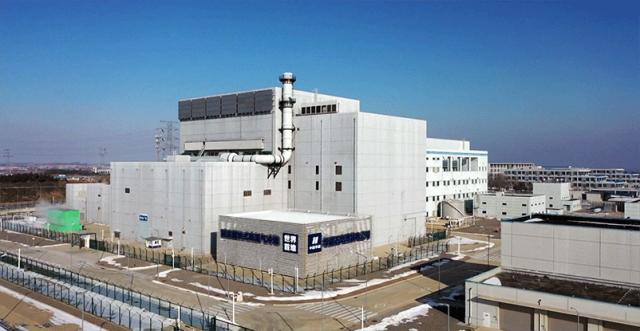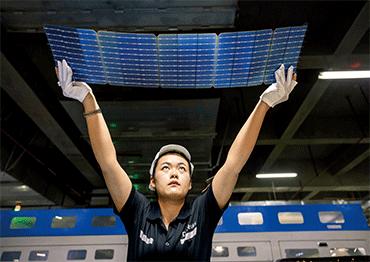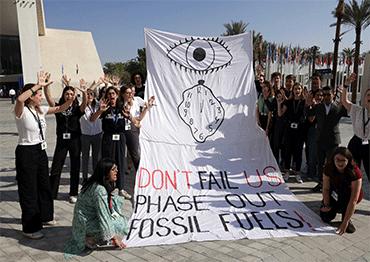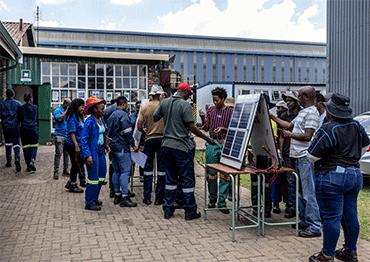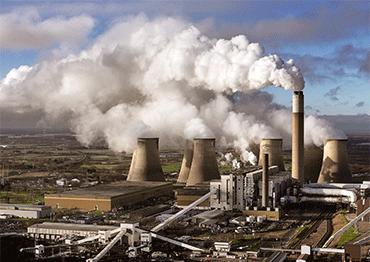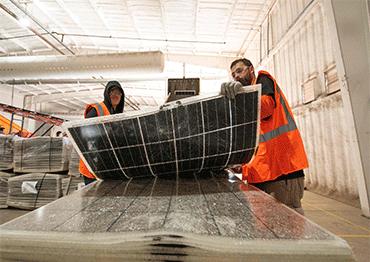n January 30, the China Electricity Council, a self-regulated national trade association of China’s mostly State-owned power enterprises and institutions, published its yearly report, which projected that grid-connected wind and solar power would make up around 40 percent of installed power generation capacity by the end of 2024 and overtake coal for the first time in the country’s power mix. Together with nuclear and hydropower, non-fossil fuel power sources accounted for over half of total installed power capacity in 2023 for the first time in history, though coal still accounted for 60 percent of electricity generation.
At an energy conference held in December 2023 that mapped out goals for 2024, Zhang Jianhua, head of the National Energy Administration, said China will strive to increase the share of non-fossil energy and the supply of clean energy. According to an estimate by the Economics and Technology Research Institute affiliated with China National Petroleum Corp, the share of coal in the energy structure will drop from 44.3 percent in 2030 to 5.8 percent by 2060.
China’s efforts to increase the supply of clean energy align with its long-term international commitments, which have been further consolidated in the past months by cooperation with major partners on climate change and participation in international action.
In early November 2023, China and the US signed the Sunnylands Statement, agreeing to resume a working group on climate cooperation and ramp up renewable energy.
In December 2023, China participated in the 28th Conference of the Parties of the United Nations Framework Convention on Climate Change (COP28) in Dubai, United Arab Emirates, the COP’s most important iteration since the signing of the Paris Agreement in 2015. It reached an agreement on “transitioning away from fossil fuels,” a first for a UN climate conference since the signing of the UN Framework Convention on Climate Change in 1992.
China’s Chief Climate Negotiator Su Wei told NewsChina that fossil fuels were the most central and challenging issue at the conference, with oil-producing countries strongly opposed to any radical COP28 resolutions about phasing out fossil fuels, which were supported by the European Union, small island countries and environmental NGOs. The final text of the UAE Consensus calls for “transitioning away from fossil fuels in energy systems in a just, orderly and equitable manner.” Su commented that it marks a “concrete step toward the energy transition of the whole world.”
In an interview with NewsChina, Su explained why China’s energy transition path is in line with the international consensus and why climate change has been a long-standing area of cooperation in China-US relations.
NewsChina: How do you interpret the final COP28 agreement? Is it consistent with China’s long-held stance on climate change?
Su Wei: “Transitioning away from fossil fuels” means that humanity will eventually end its reliance on fossil fuels one day. However, there must be a process, and in this process, two issues need to be addressed: reducing emissions and, more importantly, achieving energy substitution.
This is also what China and the US agreed to in the Sunnylands Statement, in which the countries are committed to accelerating the replacement of coal, oil and natural gas-based electricity generation with renewable and clean energy to reduce emissions in the power sector.
But energy substitution needs to adopt a “build before breaking” approach, ensuring that we have new energy sources available before gradually replacing traditional sources. In general, the UAE Consensus is consistent with China’s position and stance.
In addition, the UAE Consensus states that the final goal for 2050 is “net zero,” without specifying “zero emissions” or “zero fossil fuels.” This ambiguity leaves room for all parties to interpret it with their own understanding, avoiding any party feeling cornered. This was crucial to reach the consensus.
The path for China’s energy transition is very clear: it must be gradual and orderly. The gradual phasing-out of traditional energy sources has to be based on the security and reliability of new energy alternatives. Efforts will be made to establish a new energy supply and consumption system based on large-scale wind and solar farms, supported by clean and efficient coal-fired power plants in the surrounding areas and transmitted by stable and secure ultra-high-voltage transmission and transformation lines. In this way, China will reduce its reliance on fossil fuels in a stable, orderly way.
To reach its national goal of peak carbon by 2030, China needs to strictly control the increase in coal consumption during the 14th Five-Year Plan (2021-2025) and reduce it during the 15th Five-Year Plan (2026-2030). To reach the national goal of carbon neutrality by 2060, non-fossil energy consumption in the country has to account for 80 percent of the energy mix. Given these goals, China has to install renewable energy at large scale and replace fossil energy with reliable and safe renewables.
NC: China is already the world’s largest producer of wind power and PV solar panels. How should China continue growth in renewable energy and reduce coal use?
SW: The pace of the energy transition in China cannot be too fast or too slow, and carbon emissions are not the only thing that should be taken into consideration. Reducing carbon emissions should be part of the overall picture of economic and social development. It means a balance between development and emissions reduction, between short-term and long-term goals, as well as the relationship between government and the market. The purpose is to safeguard energy security and reduce carbon emissions in a reliable way.
The final text of the global stocktaking called for “accelerating efforts toward the phase-down of unabated coal power,” which echoes the language adopted in the agreement of the COP26 held in Glasgow in 2021. We accept this.
Chinese President Xi Jinping has clearly stated the need to strictly control coal-fired power projects, with the 14th Five-Year Plan period focusing on controlling the growth of coal consumption and the 15th Five-Year Plan period aiming for a gradual reduction. The role of coal power will shift gradually from a primary power source to a flexible and peak-shaving power source.
The direction for the transition is clear, but there needs to be a process. As for recent approvals of new coalfired power plants, it is due to the realistic need for energy security and for providing flexible power support for the massive development of renewable energy. Over time, approvals for coal power plants will decrease as non-fossil fuel energy and renewable energy develop on a larger scale. This is the trend in energy substitution and transformation.
COP28 called on countries to triple global renewable energy capacity by 2030 and double the annual rate of improvement in global energy efficiency. This could be a significant boon for China’s new energy industry, as China has competitive advantages in renewable energy equipment, technology and products.
However, achieving the goal of tripling global renewable energy capacity faces challenges in the current international environment. Many developed countries have imposed tariffs or are conducting anti-subsidy investigations on PV products and renewable energy equipment. These measures run counter to the goal of tripling global renewable energy capacity.
Moreover, developing renewable energy is not just about increasing wind and solar installed capacity, it’s also about generating electricity. If installed capacity grows too quickly without compatible infrastructure, renewable energy will remain underutilized. Therefore, accelerating the development of renewable energy requires coordinated progress in the integration of power sources, power grids, load management and power storage, ensuring that every aspect of renewable energy development is well-coordinated and interconnected.
NC: Following COP28, countries are expected to update their next nationally determined contributions (NDCs) on emission reduction plans in 2025. What new goals might China propose?
SW: The UAE Consensus encourages countries to propose more ambitious economy-wide emission reduction targets in their next NDCs in 2025, covering all greenhouse gases, sectors and categories to ensure adherence to the 1.5 C goal above pre-industrial levels. China’s new NDC in the next round will include specific emission reduction targets, detailed policies, measures and standards covering the next 5-10 years, which will require in-depth research and thorough analysis.
NC: What role did China and the US play in ultimately reaching a consensus at COP28?
SW: When China and the US issued the Sunnylands Statement in November last year, they voiced support for a successful COP28 in the UAE. The two leaders sent a clear political signal to the world following their summit in San Francisco that the world’s two largest economies could sit down to exchange views and promote practical cooperation in the field of climate change, which enormously facilitated the achievements of COP28. The move laid a solid foundation for the success of COP28, and was highly praised by countries around the world.
As negotiations became deadlocked at COP28 due to significant differences among parties on fossil fuels, China and the US communicated extensively and then jointly proposed a text. They helped unlock some of the most difficult issues and made significant contributions to reaching the UAE Consensus.
NC: Amid the tension between the two countries on various fronts, how would you assess their cooperation on climate change? Will it become a breakthrough for bilateral cooperation?
SW: Dialogue and cooperation have been the mainstream on climate change between China and the US. During the administration of former president Barack Obama, climate change was an important topic in the China-US Strategic and Economic Dialogue, and there was a dedicated working group on this issue, covering various areas including energy efficiency, the power grid and the auto industry. The cooperation was specific and pragmatic.
However, during the administration of former president Donald Trump, climate change dialogue and cooperation between the two countries essentially stalled. But things changed after President Joe Biden returned the US to the [2015] Paris Agreement and appointed former secretary of state John Kerry as special presidential envoy for climate. Kerry has been acquainted with and interacted with China’s former special envoy on climate change Xie Zhenhua in international negotiations for over 20 years.
They are both experienced negotiators. While they have different positions on some issues, they are willing to listen to each other.
Climate change is closely related to the interests of all of humanity and it is an issue where the interests of the two countries can converge. This is why climate change remains one of the few positive elements that can help stabilize and develop the bilateral relationship.
NC: How far has China-US cooperation progressed in the field of climate change? What challenges do they face?
SW: In the past three years, despite the obstacles posed by the global pandemic, teams from both China and the US, led by their respective special envoys, held eight face-to-face communications and over 60 online exchanges. These exchanges were candid and friendly, as both sides sought mutual understanding, found common ground, and addressed their differences. In April 2021, the two sides signed the China-US Joint Statement Addressing the Climate Crisis in Shanghai. In February 2022, they signed the China-US Joint Glasgow Declaration on Enhancing Climate Action in the 2020s at COP26 held in Glasgow. In November 2023, the Sunnylands Statement on Enhancing Cooperation to Address the Climate Crisis was signed.
After long negotiations, the two sides agreed to establish a routine working group to enhance action on climate, involving economic, environmental, energy and other relevant departments from both sides. It will help restore dialogue and rebuild cooperation between government agencies in the two countries. In addition, four teams under the working group will be set up, focusing on energy transition, circular economy and resources efficiency, methane and low-carbon, and sustainable provinces, states and cities.
Looking ahead, we must be aware that climate change is not just a bilateral issue. It’s a global challenge. The international community has high expectations for China-US cooperation in this regard. China-US dialogue, exchange and collaboration on climate change will play a positive role in stabilizing the bilateral relationship and bringing it back on track.
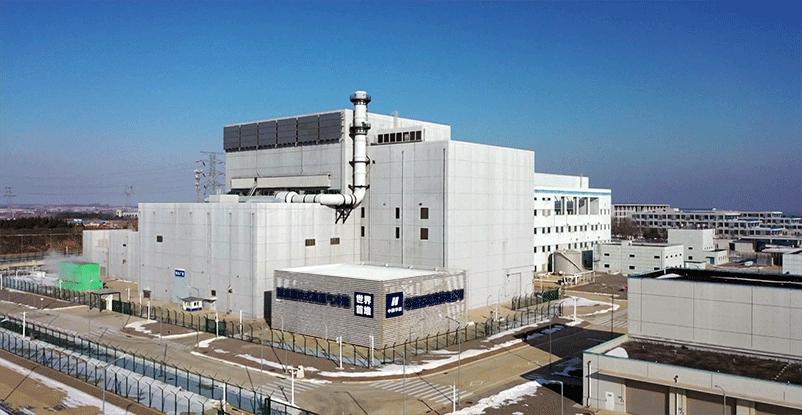
 Old Version
Old Version
